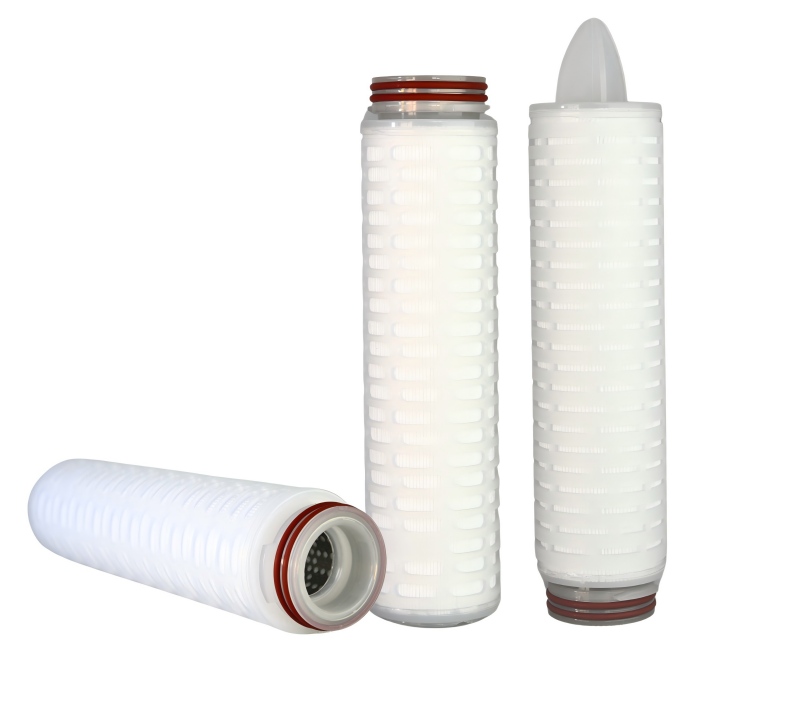What Is a PES Pleated Filter Cartridge?
2025-11-07
As a core component in the field of precision filtration, the PES membrane pleated filter cartridge is widely used in industries such as pharmaceuticals, food, and electronics due to its excellent chemical stability and high-efficiency filtration performance. Its structural design is highly compatible with filtration effects, ensuring both filtration accuracy and throughput, making it a key unit in liquid purification systems.
Structurally, the PES membrane pleated filter cartridge adopts a "multi-layer composite, pleated molding" design concept, with its core composed of four layers of functional materials. The innermost layer is the PES membrane filter layer, the core functional area of the cartridge. It is made of polyethersulfone polymer material through a phase inversion method, and the membrane surface is densely covered with uniformly sized micropores (common pore size range 0.1-10μm). These micropores form a three-dimensional network structure, which can both trap impurities and ensure smooth liquid flow. The middle layer is the support layer, usually made of polypropylene nonwoven fabric. Its high-strength fiber structure prevents the PES membrane from cracking or deforming during high-pressure filtration, and also plays a role in uniformly distributing fluid, preventing excessively high local flow rates that could lead to a decrease in filtration efficiency. The outer layer is a protective layer, mostly made of polyester fiber, primarily used to prevent external impurities from entering the filter element and to protect the stability of the folded membrane structure, preventing damage during transportation or installation. The outermost layer also includes polypropylene end caps and a central tube. The end caps are sealed to the filter housing using a hot-melt welding process, ensuring no risk of side leakage. The central tube provides a flow channel for the filtered liquid, and its perforated surface design allows for uniform liquid collection, further improving filtration throughput.
In terms of filtration performance, PES membrane pleated filter elements exhibit three core advantages. First, high-precision retention performance. Due to the narrow and controllable micropore size distribution of the PES membrane, it can effectively retain impurities such as bacteria, colloids, and suspended particles in the liquid. For example, a filter element with a 0.22μm pore size can achieve a 99.99% bacterial retention rate, meeting the stringent requirements of sterile filtration in the pharmaceutical industry. Secondly, it boasts high throughput and low resistance. The pleated structure increases the effective filtration area of the filter cartridge by 3-5 times compared to a flat sheet membrane of the same size, significantly increasing the fluid contact area. Under the same pressure, its throughput is 20%-30% higher than traditional filter cartridges. Simultaneously, the hydrophilic surface of the PES membrane reduces liquid flow resistance and energy loss, making it suitable for high-flow-rate filtration applications. Finally, it exhibits excellent chemical and thermal stability. PES material has a wide acid and alkali resistance range (pH 1-13), can withstand various organic solvents (such as ethanol and methanol), and can be sterilized at 121℃, meeting the stringent hygiene and safety requirements of the pharmaceutical and food industries. The filter cartridge's service life is 2-3 times that of traditional cellulose filter cartridges.
In practical applications, the structural design and performance advantages of the PES membrane pleated filter cartridge create a synergistic effect. For example, in the biopharmaceutical field, its multi-layered composite structure avoids secondary contamination caused by membrane detachment, while its high-precision retention performance ensures the sterility of the drug solution. In the preparation of ultrapure water in the electronics industry, its high-throughput characteristics improve water treatment efficiency, while its chemical stability prevents the filter element from reacting with the purified water, ensuring water purity. Furthermore, the folded structure of the filter element makes it compact, adaptable to various sizes of filtration equipment, reducing the equipment's footprint and further expanding its application scenarios.





